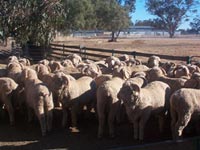
QPLU$ shows how to boost wool returns from Merino flocks

QPLU$ sheep show high return from careful
breeding of existing flocks.
A unique Merino breeding project, conducted over the last decade, has demonstrated that it is possible for wool growers to significantly boost returns from existing Merino flocks, if they breed from animals selected on the basis of measured fleece weight and fibre diameter.
Final estimates of improvements in fleece value from the QPLU$ flock will be presented to growers at an open day at the Trangie Agricultural Research Centre on May 11 hosted by the NSW Department of Primary Industries and Australian Wool Innovation.
NSW DPI Livestock Research Officer, Pat Taylor, said all lines have displayed substantial and predictable improvements in the traits under selection and, as a consequence, in the monetary value of wool produced.
“At the extremes, we have measured a 19% increase in fleece weight in a medium wool line dedicated to maximising fleece weight but maintaining fibre diameter.
“There was also and a reduction in fibre diameter of over 2.4µm in a medium wool line dedicated to minimising fibre diameter but maintaining fleece weight.
“Responses in the other lines fall within this range and are fairly close to our original predictions.
Mr Taylor said the final estimates of improvements in fleece value will be calculated when measurement of a number of other wool traits that influence wool prices have been completed in the near future.
The Qplu$ selection lines, designed by DPI Principal Research Scientist Dr Kevin Atkins, were created to demonstrate the potential within all Merino flocks to steadily increase wool profits by selecting sires and dams based on measured fleece weight and fibre diameter.
The lines were established from the progeny of stud quality ewes and rams representing the fine, medium and broad wool Merino strains purchased by NSW DPI in 1992 and 1993.
Mr Taylor said DPI researchers are currently also measuring a range of other production and wool quality characteristics to determine if other important traits have changed as an indirect consequence of single minded selection on fleece weight and fibre diameter.
These results and the sheep bred within each line will be presented on May 11 this year.
“This may be the final opportunity to inspect these sheep so we encourage anyone interested in genetically improving wool profits from Merinos to attend the open day”, Mr Taylor said.
Further information
The QPLU$ project is funded by NSW DPI and Australian Wool Information.
Pat Taylor, Livestock Research Officer, NSW DPI, Orange on 02 6391 3916 or pat.taylor@dpi.nsw.gov.au.
Email:

